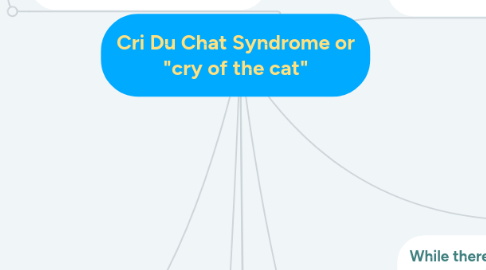Cri Du Chat Syndrome or "cry of the cat"
by Jamie Lewis

1. Is also known as 5p minus Syndrome and is a genetic condition which is caused by a deletion of genetic material on the small arm (the p arm) of chromosome 5.
1.1. While cri du chat syndrome is a genetic condition, most cases are not inherited.
2. Pathophysiology: *Partial deletion of the short arm of chromosome 5 is responsible for the characteristic phenotype. *The characteristic cry is perceptually and acoustically similar to the mewing of kittens. The unusual cry is due to structural abnormalities of the larynx and central nervous system dysfunction. Although the laryngeal appears to be normal anatomical abnormalities include floppy epiglottis, small larynx, and asymmetrical vocal cords. The cause of the characteristic cry is due to a developmental field may connect the brain and the affected clivus region of the cranial base with the laryngeal region from which the characteristic cry derives. *This syndrome is caused by a partial or total deletion of genetic material on the short arm of chromosome 5. The size of the deletion may affect from region 5p15.3 to the complete loss of the short arm. * Genotype-phenotype studies led to the identification of two separate chromosomal regions, hemizygosity for which is associated with specific phenotypes. * Deletion of the 5p15.2 results in the presentation of the other major clinical features of the syndrome. *5p15.3 is responsible for speech delay.
3. Diagnosis consists of medical history, symptoms, physical exam, and laboratory testing
3.1. Genetic Testing Registry (GTR) provides information about genetic tests specific for this condition.
4. This syndrome is characterized by a distinctive high-pitched catlike cry in infancy, growth failure, microcephaly, facial abnormalities (epicanthus, low-set, posteriorly rotated ears), and mental retardation.
5. Risk factors of the syndrome include a parent with chromosome 5 abnormality. Most cases occur when the chromosome in either the egg or the sperm breaks randomly prior to fertilization. 80% of the time the chromosome abnormality comes from the male's sperm not the female's egg.
5.1. Estimated prevalence is about 1 in 50,000 live births. The prevalence among individuals with mental retardation is about 1.5 in 1000.
6. Common Findings include: high-pitched cat-like cry, mental retardation, delayed development, distinctive facial features, microcephaly, hypertelorism, low birth weight, hypotonia, difficulty with language, feeding difficulties, hyperactivity, and scoliosis.
7. Laboratory Studies include: Conventional Cytogenetic studies, High-resolution cytogenetic studies, fluorescence in situ hybridization (FISH), Chromosome comparative genomic hybridization (CGH), Microarray CGH, and SNP-based test.
8. While there is no specific treatment for cri du chat syndrome children with this condition require supportive care in the form of parental engagement, physical and language therapy, medical and educational enrichment to help patients achieve maximum potential.
8.1. People with this condition usually have a normal life expectancy. Both children and adults with this syndrome are usually friendly, happy and enjoy social interaction.


